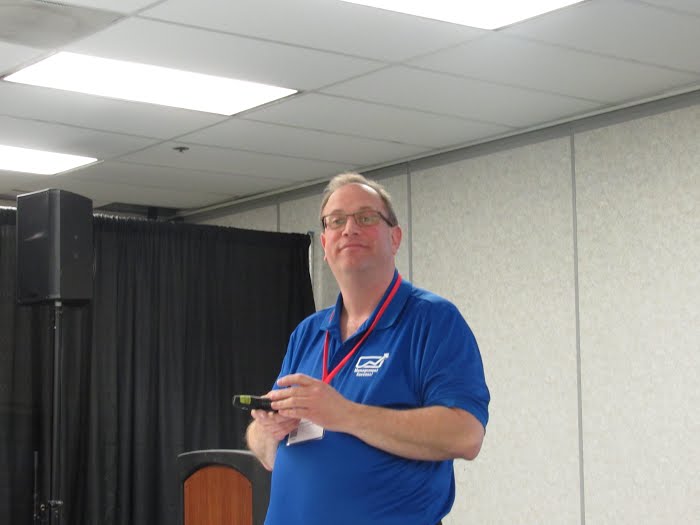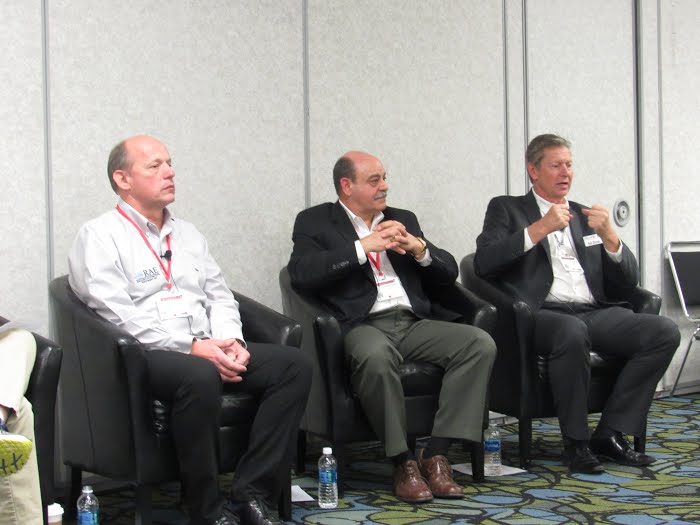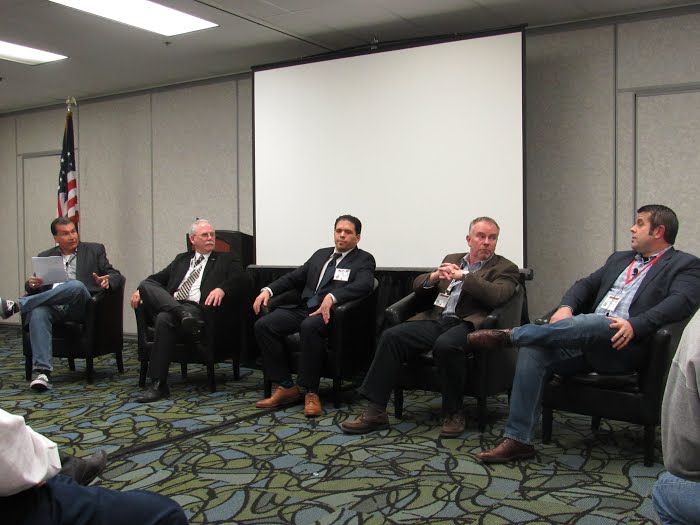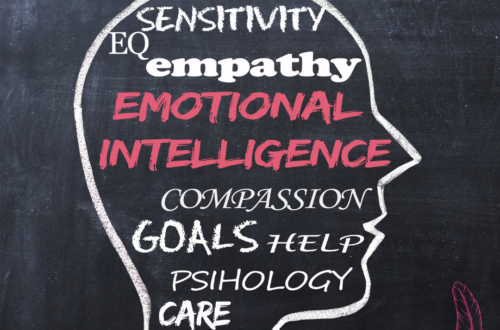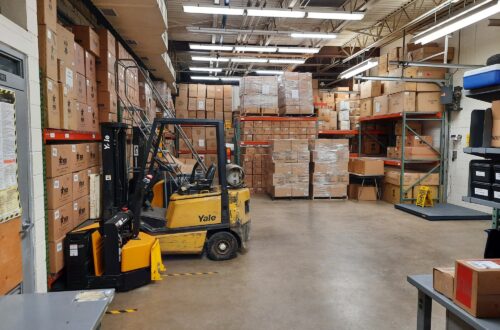AASP/NJ’s 40th Annual NORTHEAST Bigger and Better Than Ever
Tuesday, 28 March 2017 21:17
Featured in AUTOBODYNEWS

With 2017 marking AASP/NJ’s 40th Annual NORTHEAST Conference and Tradeshow, it comes as no surprise that this year’s event, held at the Meadowlands Exposition Center on March 17-19, was bigger and better than ever with a handful of firsts.
AASP/NJ hosted a four-part Path to Certification panel series and presented the first James Moy Memorial Award for Dedication to the Automotive Repair Industry. Additionally, this was the first agenda to include presentations from Superare Marketing, and Mike Anderson of Collision Advice presented a brand new seminar on the importance of disassembly.
According to AASP/NJ Executive Director Charles Bryant, “The 2017 NORTHEAST Automotive Tradeshow was once again a great success. These are not just my words; this is what I constantly heard from people at the show and from people that attended the show who have called to comment after the show. There was something for everyone at the NORTHEAST Tradeshow, from the most informative seminars to the most modern tools and equipment available in the industry. Every year, the Northeast Tradeshow seems to get better and better, making it a must-attend event for the members of the industry. Congratulations to all that played a part in making the Northeast Tradeshow available to the many members of the automotive industry.”
On Friday afternoon, AASP/NJ and SCRS co-hosted the annual East Coast Resolution Forum and Leadership Meeting. This closed session offered industry leaders an opportunity to discuss collision repair concerns and brainstorm solutions as a group.
Friday evening’s seminars began with AASP/NJ’s Path to Certification: The Shop Owner’s Perspective, a panel discussion moderated by Gary Wano of GW & Son Auto Body Shop, which featured Tom Elder of Compact Kars Inc, James Carvino from Rojo Collision, Rick Starbard of Rick’s Auto Collision & Repair, and Barry Dorn from Dorn’s Body and Paint. All of these shops are heavily certified by a variety of OEMs, and they shared their experiences during this session.
When questioned about how they got involved with the certification process, responses varied from being approached by the OEM, the shop pursuing the certification, or being dealership driven, depending on the manufacturer. The transition to becoming certified includes audits from the OEM to view the shop setup, equipment requirements and training standards.
Carvino noted, “You have to look at every aspect of how you run the business slightly differently because the scope of work changes,” and Dorn added, “You have to change the way you and your team think. It’s a culture shift so you really need your team to buy in, and it can be a challenge, but like all challenges, the reward is there when you get through the process; you sleep well knowing that you’re doing the right thing.”
Considering which technicians to send for the OEM required training is also an important step since it can be such an expensive process. A lot of the OEMs require I-CAR Gold training, but some require additional courses and education. Elder admitted, “It takes a lot of time, effort and pride to make it work.”
Dorn contributed, “You have to choose someone who’s passionate because you want to have every possible advantage to pass.” The overall consensus among the panel participants was that OEM certification requires diligent shop owners who are willing to obtain the training necessary to properly repair specific vehicles.
The panel discussed customer expectations for certified shops, the challenges inherent in technological advancements, and the importance of blueprinting. Dorn stressed, “There are procedures that change weekly, so you have to pull the OEM specs on every single repair. Keep in mind that consumers are relying on this technology, and if it’s not properly calibrated, it can cause major issues and be extremely dangerous!”
A useful benefit of OEM certification, according to the panel, is that they’ve found it easier to justify the use of OE parts to the insurers since the manufacturers’ requirements necessitate their utilization. Dorn noted, “OEs are demanding like insurers, so we need the carriers to understand the differences between original and aftermarket parts. There’s a learning curve to get them to understand the real cost behind what we do; the certification process is very stressful but worth the effort.”
Since obtaining their OEM certifications, some of the shop owners reported reducing the number of DRP relationships they’d previously had, but most of the panel members still participate in some DRPs. According to Elder, “Our price is our price, and that’s what we charge. We got rid of the DRPs that require substandard parts and processes, but I don’t have a problem with the others as long as they let me follow OE requirements, charge a fair rate, and perform a proper repair for the consumer.”
Regarding how customers react to the OEs referring them to certified shops, Carvino shared, “Customers want certified shops and really get behind us because they want to feel confident that their car is being taken care of.”
Taking the money, time and resources required into consideration, Wano asked if the shops would go through the certification process again, and the response was a resounding “yes!” Elder “wouldn’t do it any other way,” and Carvino stated, “It’s meaningful to see that certification.” Starbard insisted, “With all cars becoming so high-tech, you need to step your game up,” while Dorn added, “OEM certification takes your shop to the next level, and the sense of pride you see in your team makes it worthwhile.”
Friday night’s offerings also included “Ford High Voltage Vehicles Components and Operations,” presented by Mike Brabble, Ford Motorcraft Technical Trainer, and facilitated by Flemington Car & Truck Country. Recommended for all aftermarket service technicians interested in high voltage vehicle technology, the course provided some of the latest information on advanced automotive technology. Ford Service Engineer Gerry Bonnani provided examples of the improved repair elements of the aluminum F-150 in “Aluminum F-Series Collision Repair Information,” and Collision Advice’s Mike Anderson shared “Who Pays for What? Survey Results” in a presentation sponsored by Axalta Coating Systems.
Also on Friday evening, Jim Saeli of Management Success shared tips to “Supercharge Your Profits.” Beginning by telling attendees that some shops aren’t getting paid like they should, Saeli encouraged them to take a look at what isn’t working well enough so they can fix the real problem. “Too often, shop owners work harder than anyone and make less money. You should be paid well for all you do!”
The process begins by watching your numbers and connecting the dots. Shops may have plenty of work, but they need to get it out the door in a timely manner. Saeli warned, “Owners often get stuck on one thing and miss the big picture. You have to track your numbers, not go by your gut or rely on emotions. A common fixation is that a shop needs more cars or better marketing, but I often find that you’re trying to fix something that isn’t broken. The most frequent issue is that shops don’t have anyone up front who can sell. Your sales guys should be doing 80% or better. You need to make time for estimates and invest in a real sales department.”
Saeli continued, “Making money comes from efficient problem-solving and then getting paid well for the skills and solutions your team provides. Without evaluating your key numbers, you’re running blind, but your vision improves once you start tracking those numbers. You need statistics for each step of the process. You will make money if your numbers are where they should be, and then your customers do your marketing for you.”
Shops must track numbers for each person in the business to ensure they are producing, and putting those numbers into graphs paints a picture and helps easily identify problem areas by revealing what needs to be fixed and what strengths to focus on. “It gives you better control and understanding so you can start making the money you always thought you should,” Saeli emphasized.
Noting that the people working at a shop are the number one thing to make or break a business, Saeli turned to recruiting which should be a full-time endeavor. He dropped a “truth bomb:” “You can’t hire great employees, but you can hire great potential employees. It’s management’s job to cultivate that potential and to create a great working environment.”
Basic marketing techniques are required to recruit a prospective employee, it begins by knowing what employees are looking for in a business: well-equipped, good environment, location and benefits; money is not a driving factor, but showing appreciation makes a huge difference. Business owners need to sell recruits on joining their team and look for people with the right attitude.
Pointing out that people (not cars) have problems, Saeli stated that employees should be friendly, observant, and enjoy helping customers solve their problems. After discussing efficiency expectations for technicians, Saeli noted that expenses should consist of these percentages: 18% technician pay, 30% cost of parts, 8% front office, 24% overhead, and 20% owner pay, but “If you’re still working in your shop, you should be pulling in more than 20%.” He added, “Treat your employees right because they are as important as your customers – they’re your most valuable asset!”
On Saturday morning, Jerry McNee and John Niechwiadowicz hosted an interactive workshop designed to help shops explore ways to become more efficient, productive and profitable, entitled “Open Your Eyes… and You WILL Become a Game Change.” They delivered an encore presentation on Saturday afternoon. At the same time, Peter Fryzel and Michael Bonsanto taught I-CAR Vehicle Technology Trends and Diagnostics Overview (VT117L01) off-site at the Embassy Suites, located next door to the Meadowlands.
Also on Saturday morning, Larry Montanez of P & L Consultants held “Proper and Accurate Blueprinting with Pre-Scan and Pre-Measure,” with assistance from asTech’s Jake Rodenroth and Metropolitan Car-O-Liner’s Anthony Cetani. The trio explored two specific and important procedures for preparing a vehicle for repair, measuring and scanning. James Meyer, Senior Collision Training Administrator for Toyota, presented “Toyota OE Resources: Get Connected” on Saturday morning and again Sunday afternoon. The Women’s Industry Network (WIN) also held a seminar on “Engaging Women in Collision Repair.”
Beginning at 11AM, the Assured Performance Network’s Aaron Clark moderated AASP/NJ’s Path to Certification: The OEM Perspective (Non-Luxury Brands) with a panel consisting of Ford’s Mark Mandl, Dave Pyle from Toyota, Gary Ledoux of American Honda, and FCA’s Brian Wayne. The OEM representatives discussed their specific eligibility requirements, all of which are based on training, tools, knowledge and the facility itself. In addition to their own training requirements, all of the OEMs present require I-CAR Gold status, except Toyota which uses its own benchmarks, but Honda will accept VQ status through VeriFacts in lieu of the I-CAR classification.
Discussing the role of certification in the shop’s relationship with insurance companies, Wayne mentioned the ability to leverage improved CSI, and Mandl stressed that how the shop is promoted to the insurers is critical. Pyle encouraged shops to educate consumers on the difference between OE and aftermarket parts so the customer can have an educated conversation with their insurance carrier.
While the OEMs do not generally have parts restrictions, FCA and Honda both have restrictions for certain models, and they all prefer the use of original parts. Although MSOs continue to be an industry trend, the manufacturers’ requirements for certification are exactly the same for independent shops and MSOs.
When it comes to consumer awareness, each OEM does its best to teach consumers that they can choose the shop that repairs their vehicle, and they all deliver messages about the benefit of going to a certified facility. Wayne noted, “We want to add the right shops to our program, and we try to drive consumers to our certified shops so their vehicle is repaired properly the first time. In 60% of re-repairs, the customer switches cars within 12 months, and 62% of them change brands. We don’t want to lose customers due to a poor repair.”
The OEs determine their coverage needs for any given area based on the number of their vehicles driven in that area, and while the manufacturers’ certification requires that the shop possess the tools and information for proper procedures, Clark reminded attendees that it is ultimately up to the shop to adhere to those guides and perform the repair properly and safely.
Summarizing the OEMs’ goal in certifying shops, Mandl said, “We are trying to set standards in the industry with the consumer at the center because we want to make sure their vehicle has been repaired properly. OEs, shops and insurers have the same customer, and we all want to do right by the consumer. Certification is a great way to do that.”
From 12:30-2PM, “2020 – The Future of Staffing: Where Will You Be?” was presented by Mike Lanza of Sherwin-Williams as he used analysis, statistics and trends to forecast the next few years and discussed how to attract, train and retain the industry’s best employees. In the demo area, Michael Finazzo from Absolute Perfection Media discussed “Shifting Your Online Marketing into High Gear for 2017;” an encore presentation was scheduled on Sunday morning.
On Saturday afternoon, Collision Hub’s Kristen Felder moderated AASP/NJ’s Path to Certification: Tooling and Equipment Considerations, a panel which included David Gruskos from Reliable Automotive Equipment, Frank Ponte of Car-O-Liner, and Prospot’s Ron Olsson. These tool company representatives described the extensive research and testing that OEs do before certifying a tool, and they also stressed the importance of following OEM procedures in order to safely restore a vehicle to its pre-loss condition.
Gruskos explained, “The OEM has a financial interest in ensuring a proper repair. Certain procedures require specialized equipment, and the manufacturers want to develop a list that’s economically feasible for the shop, but the safety of the consumer and the technician is the most important consideration. A lot is driven by safety – do it right or don’t do it at all!”
Ponte added, “The manufacturers test and retest the equipment to ensure it performs to the expected standards. They know they are asking shops to make an investment so they want it to be a good, long-term investment with ROI, and they also verify that the necessary product support is available.”
The panel discussed the variety of challenges posed by advancing technology and the multitude of metals and alloys. Olsson noted, “We try to build the best possible equipment to accommodate the different metals, and the quality of the equipment you buy becomes obvious through use. It’s imperative that the technicians learn how to use the equipment; you have to commit to training and knowing what you’re doing.”
Additional topics included maintaining the equipment, the importance of training and education, and the need for each shop to evaluate its own business needs. Ponte urged shop owners to do their research before purchasing equipment to be confident they’re making a wise investment: “Your responsibility is to find out what you actually need based on OEM requirements and the vehicles you repair. You should be prepared to buy the best. I’ve never had a customer complain about buying the best, but if you base your decision on price, you may regret it down the road.”
Felder left the audience with an important reminder: “There will be some vehicles you can’t repair, not because you don’t have the skills, but because you simply cannot afford every piece of equipment… Even if you’re not interested in OE certification, you still need to make sure you’re using the right equipment if you’re repairing that brand.”
On Saturday afternoon, Peter Fryzel and Michael Bonsanto shared information on I-CAR’s joining process training in “I-CAR Certification and Technical Hour.” During Larry Montanez’s “Take Back Your Business from the Rekey Process,” Montanez took a moment to honor his friend and industry legend, James Moy, as he presented Barry Roopnarine with AASP/NJ’s first annual James Moy Memorial Award for Dedication to the Automotive Repair Industry.
The penultimate educational session on Saturday was AASP/NJ’s Path to Certification: The OEM Perspective (Luxury Brands) which was again moderated by the Assured Performance Network’s Aaron Clark. Audi’s Mark Allen and Benito Cid of Mercedes-Benz participated in this panel, discussing their tool and training requirements as well as the need to be sponsored by a dealership to be considered for certification and the costs of enrolling in the program.
Talking about how OEM certification impacts shops’ relationships with insurers, Cid pointed out that it’s important to stay updated since repair procedures change constantly, and he encouraged the education of insurance appraisers so they can understand why shops ask for certain items. “It’s actually the repair procedure that needs to be done to restore the vehicle per manufacturer specifications.”
Neither Audi nor Mercedes-Benz restrict access to information about repairing their vehicles, but they both restrict repairs on certain aluminum structures due to the complexity, and Audi also restricts the repair of certain carbon fiber components. The time it takes to acquire certification varies greatly based on the shop with the OEM representatives reporting ranges from several weeks up to eight months. Both manufacturers encourage customers to have their vehicles repaired at certified shops and offer a variety of logos and signage to help shops advertise their certification.
Allen noted, “We understand our requirements are different because we manufacture high-end vehicles, but we expect other OEMs to start having similar requirements. We recommend business owners start thinking about it. Shops must meet our expectations, and sometimes cultural differences mean they just aren’t a good fit for certification.”
Saturday’s conference ended with a brand new presentation by Mike Anderson of Collision Advice: “100% Disassembly and Parts Mirror Matching.” Anderson debuted this seminar to a packed room.
Sunday morning featured educational seminars presented by Tony Lombardozzi and Peter Abdelmaseh of Superare Marketing. In “Stop Playing by the Appraiser’s Rules,” they explained their approach to dealing with insurance appraisers, and the dynamic duo shared strategies for setting legally binding prices in “Set Your Prices and Make Them Stick.”
Over 100 exhibitors participated in the 2017 NORTHEAST Tradeshow, and this year’s booths were bigger and better than ever with multiple vehicles on display, representatives from the largest paint and supply companies, and vendors representing every segment of the industry. The tradeshow was open on Friday night at 5-10PM, followed by the Exhibitor Appreciation After-Party. The tradeshow continued from 10AM to 5PM and 10AM-3PM on Sunday.
AASP/NJ’s 2018 NORTHEAST Conference and Tradeshow will take place on March 16-18, 2018.
